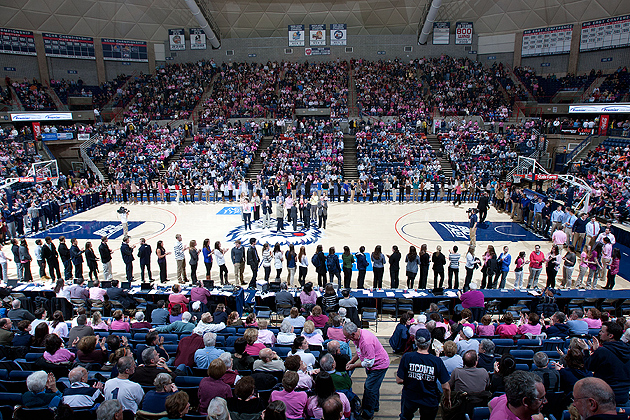The University of Connecticut men’s basketball team posted an outstanding Academic Progress Rate (APR) score of 978, out of a possible 1,000, for the 2010-11 academic year.
“Our men’s basketball team had an outstanding APR score for the 2010-11 season and I want to congratulate the student-athletes, Coach Calhoun, and the rest of the coaching staff for that accomplishment,” said UConn Director of Athletics Warde Manuel. “I think it is particularly noteworthy that they accomplished this during an academic year when they won an NCAA championship. The men’s basketball team will have another outstanding academic year in 2011-12.”
The NCAA announced its latest report of the Academic Progress Rate (APR) for all Division I schools on Wednesday. The multi-year rates include the four academic years from 2007-11, and the single-year scores are for 2010-11.
Twenty of the 24 athletic programs at the University of Connecticut achieved a score of 975 or better, out of a possible 1,000, in the multi-year Academic Progress Rate (APR), while 16 of 24 had scores over 975 for the 2010-11 academic year. A total of three Husky teams had perfect 1,000 multi-year scores, while five had perfect single-year scores.

Among the highlights for UConn in the latest NCAA report were:
* The single-year score of 978 by the men’s basketball team in a season in which UConn won the NCAA national championship.
* A multi-year score of 990 for the women’s basketball team during a time period in which UConn won two national championships.
* A multi-year score of 963 for the football team during a time period in which UConn played in bowl games in all four seasons. The football team’s score is 11 points higher than the average score for all Football Bowl Subdivision teams.
* A single-year score of 1,000 for the baseball team in a season in which UConn advanced to the NCAA Super Regionals.
* A perfect 1,000 multi-year score for the men’s cross country, women’s tennis, and men’s golf teams, and a perfect 1,000 single-year score for the baseball, field hockey, men’s tennis, women’s tennis, and women’s cross country teams.
“I want to congratulate the student-athletes on all 24 of our teams for their outstanding success in the classroom,” said Warde Manuel, UConn director of athletics. “The commitment of our Husky student-athletes to excellence in both academics and athletics is a source of pride to our entire university. I want to thank the coaching staffs of all our sports and the staff of the Counseling Program for Intercollegiate Athletics for all their efforts as well.”
Those Husky teams that scored a 975 or higher on the multi-year scores were: baseball (979), women’s basketball (990), men’s cross country (1,000), women’s cross country (978), field hockey (992), golf (1,000), men’s ice hockey (981), women’s ice hockey (975), women’s lacrosse (990), women’s rowing (984), women’s soccer (985), softball (988), women’s swimming and diving (983), men’s tennis (992), women’s tennis (1,000), men’s indoor and outdoor track and field (975), women’s indoor and outdoor track and field (993), and women’s volleyball (988).
UConn teams that scored a 975 or higher on the single-year score were: baseball (1,000), men’s basketball (978), women’s basketball (976), women’s cross country (1,000), field hockey (1,000), women’s lacrosse (990), softball (985), men’s soccer (977), women’s swimming and diving (1,000), men’s tennis (1,000), women’s tennis (1,000), men’s indoor (989) and outdoor (986) track and field, and women’s indoor and outdoor track and field (991), and volleyball (976).
Last week, the NCAA announced that three UConn athletic programs were recognized for top academic performance as part of the NCAA’s academic reform program. Based on their most recent multi-year Academic Progress Rates, the UConn men’s golf, women’s soccer, and women’s tennis programs have earned NCAA Public Recognition Awards. These awards are given each year to teams scoring in the top 10 percent in each sport with their APRs.
The release of the APR also included a summary of penalties for UConn that contained a postseason ban on men’s basketball for the 2012-13 season for its four-year APR score. The team also received a “Level One” Penalty, which will limit the team to practice five days a week (as opposed to six) and 16 hours of countable activities per week (as opposed to 20).
“As I have stated before, I hope that the NCAA will continue to consider the timing of the implementation for our postseason ban for 2012-13,” said Manuel. “When the change in legislation for postseason bans was adopted by the NCAA Board in October 2011 and made effective for the 2012-13 academic year, it gave the illusion that institutions had time to adjust to the legislation. Yet the data had already been submitted under a different penalty structure, one that would not have excluded our men’s basketball team from participating in the post-season. The approach to APR marks the first time in the history of the NCAA that it has ever implemented an academic rule significantly impacting current student-athletes without allowing the members time to adjust to the adoption of the legislation.
“All of us are disappointed in this potential postseason ban, but this is a time that we need all Husky fans to support our men’s basketball team more than they ever have before,” Manuel added. “We have a championship men’s basketball program here at Connecticut and it is going to stay that way. We need our fans to come to games this season and cheer louder than they ever have before. Our student-athletes are wearing the UConn jersey, competing hard for our school, and are great people.”


